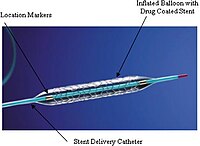
Photo from wikipedia
Supplemental Digital Content is available in the text. Background: Uncertainty exists over whether stents commonly used for percutaneous coronary intervention have comparable short- and long-term safety. The objective of this… Click to show full abstract
Supplemental Digital Content is available in the text. Background: Uncertainty exists over whether stents commonly used for percutaneous coronary intervention have comparable short- and long-term safety. The objective of this study was to determine the outcomes of patients treated with bioabsorbable polymer everolimus-eluting (BP-EES; Synergy, Boston Scientific), durable polymer everolimus-eluting (DP-EES; XIENCE, Abbott Vascular), or durable polymer zotarolimus-eluting (DP-ZES; Resolute, Medtronic) stents in routine clinical practice. Methods: All percutaneous coronary intervention cases from 48 hospitals performed after the introduction of the BP-EES stent in 2015 until the first quarter of 2018 were included. Propensity-matched multivariable analysis was used to adjust for differences in baseline characteristics and procedural variables. After matching, we performed pair-wise comparisons between DP-EES and BP-EES, DP-EES and DP-ZES, and BP-EES and DP-ZES for in-hospital postpercutaneous coronary intervention outcomes. We also evaluated 2-year postdischarge mortality in a subset of patients who could be matched to Medicare data. Results: During the study period, 53 724 percutaneous coronary intervention cases were performed. A total of 59% of patients were treated with DP-EES stents, 14% with BP-EES stents, and 27% with DP-ZES stents. Although baseline characteristics of patients differed between stent types, these differences were attenuated after matching. In the matched cohort, there was no difference in in-hospital mortality, stent thrombosis, or postprocedural stroke (a falsification end point) between BP-EES, DP-EES, and DP-ZES. After matching, there was no difference in 2-year postdischarge mortality (DP-EES versus BP-EES hazard ratio 0.91, P=0.50; DP-EES versus DP-ZES hazard ratio 1.03, P=0.77; BP-EES versus DP-ZES hazard ratio 1.20, P=0.29). Conclusions: Our data suggest similar risk-adjusted in-hospital outcomes among drug-eluting stent platforms commonly used in clinical practice. The absence of a difference in 2-year mortality between BP-EES, DP-EES, and DP-ZES suggests that stent choice decisions could be made based on other factors, including durability, availability, and cost.
Journal Title: Circulation: Cardiovascular Interventions
Year Published: 2021
Link to full text (if available)
Share on Social Media: Sign Up to like & get
recommendations!